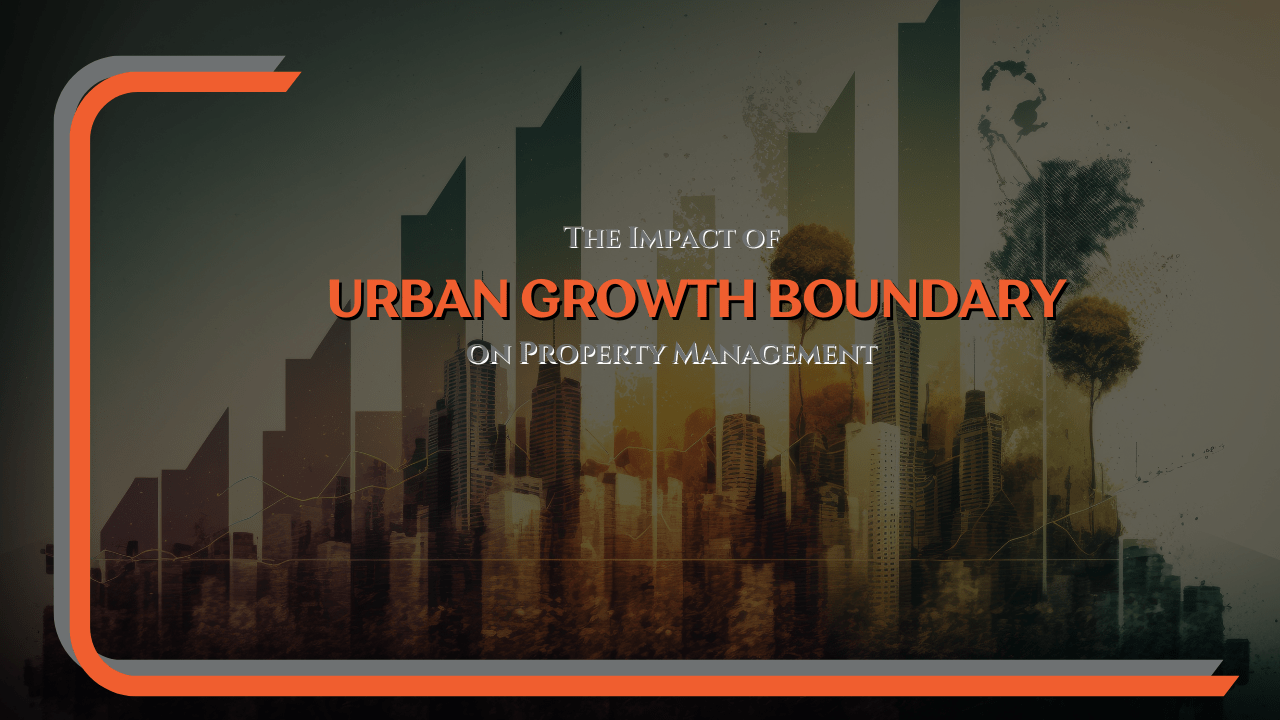Portland, Oregon, has always considered itself a leader when it comes to sustainable urban living. The city has been at the forefront of a number of trends in real estate, conservation, transportation, and public administration. The leadership around urban planning and sustainable development has also been part of Portland’s identity for quite some time.
One of the local policies that is most discussed and debated is the Urban Growth Boundary (UGB) – a regional line that controls expansion and helps in preserving the natural landscape and agricultural land outside of that boundary.
This distinctive regulatory measure not only shapes the city’s physical growth but also has significant implications for property management within the city. Whether you’re a real estate investor, a developer, a landlord, or a homeowner or tenant, you are likely impacted by this boundary and both its intentions and its effects.
Real estate investors and property managers operating within Portland need to be acutely aware of how the UGB impacts the property market. Because we have so many rental property owners and investors asking us about the UGB, we decided to put together this explanation of how it impacts us as Portland property managers and what it means for you, if you’re renting out property here or thinking of investing in and around Portland.
Let’s go ahead and talk about the current effects and potential future impact of Portland's UGB and what this means for your investment and property management strategies.
Understanding Portland's Urban Growth Boundary
One of the reasons so many people have moved to Portland is that they love the city’s proximity to forests, farms, mountains, and natural beauty. It’s easy to live here and still quickly escape the urban area. While most cities expand out as they grow, Oregon established an urban growth boundary law to control how much expansion is permitted in Portland.
First introduced in 1973, the UGB was implemented as part of Oregon's statewide land-use planning program with the intent to combat urban sprawl. The UGB encompasses the metropolitan area, distinguishing land that’s urban from land that’s rural.
Since then, Portland’s approach has been a model for other cities looking to curb unrestrained growth, maintain green spaces, and encourage denser urban development. It’s a well-intentioned plan, but one that often comes with unexpected challenges and consequences.
Land inside the urban growth boundary is generally used in support of local urban services such as roads, water, and sewer systems. There must also be supports in place for Portland’s parks, schools, and emergency services like fire and police. The boundary is one of the tools to protect local farms and forests from urban sprawl and promote the efficient use of land, public facilities, and services inside of that boundary.
According to this law, the Metro Council must review and report on the land supply every six years. This is published in the Urban Growth Report. Metro Portland prepares a forecast of population and employment growth for the region for the next 20 years and, if necessary, adjusts the boundary to meet the needs of growth forecast for that 20-year period.
The Portland area urban growth boundary has been expanded more than 30 times since it was first drawn. In 2007, a system for designating urban and rural reserves was put in place, further honing criteria for bringing land into the boundary.
Impacts on Property Values and Demand
As we have explained, the UGB contains urban development, which generally results in limited land supply within the boundary and, consequently, an increase in property values due to the classic economics of supply and demand. Because there is only so much growth that will be permitted within the city of Portland, the current supply of housing is in high demand. Space is at a premium. Buyers must be willing to pay higher prices in order to acquire a home. Renters, as well, must be prepared to pay more in a competitive rental market.
For investors and property managers, this constraint means that potential investment properties may come with a higher price tag than those in more sprawling metropolitan areas where growth is less impeded.
As we measure the supply against the demand, you have to remember that because Portland is limited in how outwardly it can grow and expand, there is an increased focus on developing existing spaces more efficiently. Smart investors will be evaluating what can be done with what we already have.
This creates opportunities for investors in terms of redevelopment and for property managers in optimizing the use of space in residential and commercial properties.
High-Density Housing is Trending
Because everyone is thinking about the importance of sustainable development, Portland's UGB has led to an increase in high-density housing projects which planners and developers hope will deliver the solutions to rising demand and diminishing supply.
Properties within the UGB must be designed to maximize utility and leverage existing space and resources. Apartment complexes, multiplexes, and high-rise residential buildings are becoming more common, because that’s the best way to accommodate the people who want to live inside the boundaries of the city.
As a property manager or investor, understanding how to make the most of these types of properties is key. This is the future of Portland’s rental landscape; new construction neighborhoods of single-family homes do not make sense. A new apartment building or an expanded apartment building, however, does make sense.
Prepare for adapting strategies to meet the demands of a market where yard space is scarce and shared amenities are not only valued, but now required.
Transportation and Capacity: Investment Opportunities in Development
Public transit is one of the best, most affordable, and more popular ways for people to get around Portland. There’s bus service, the MAX light rail, and a streetcar.
Public transportation within the UGB has been developed as a support system to the dense urban core. This has given rise to transportation-oriented developments, where residential and commercial properties are built around transit hubs. These areas present a unique angle for real estate investments and require property managers to have strategies catering to residents and businesses that prioritize transit accessibility.
When you’re investing, we recommend that you consider public transportation. Are you choosing a property that will meet the needs of tenants who want to bike, walk, or take some sort of public transit? This needs to factor into your investment goals and strategies, especially as population grows in Portland. We are using this as a big part of marketing rental homes that would be attractive to those tenants who prefer a car-free lifestyle.
Adapting Property Management Practices
 As Portland property managers, we’re attentive to the UGB and any changes that surround it. Leaning into the expectations of a population accustomed to urban living within a controlled growth environment, property managers have been called to adapt by focusing on the unique needs of urban tenants and property owners. Inside of Portland, we are following the efforts of developers and contributing to conversations around the efficient use of space, environmental sustainability, and community amenities. These are likely to be top priorities for Portland property managers going forward. If you’re an investor here, you’ll want to make sure you’re paying attention.
As Portland property managers, we’re attentive to the UGB and any changes that surround it. Leaning into the expectations of a population accustomed to urban living within a controlled growth environment, property managers have been called to adapt by focusing on the unique needs of urban tenants and property owners. Inside of Portland, we are following the efforts of developers and contributing to conversations around the efficient use of space, environmental sustainability, and community amenities. These are likely to be top priorities for Portland property managers going forward. If you’re an investor here, you’ll want to make sure you’re paying attention.
We are encouraging the protection of investors and property owners while aligning with the local population’s interest in green management practices, space-saving features, and new smart technology that’s helping buildings be more efficient. We’re highlighting efficiency and transportation ease in property listings, and assessing the ROI of providing community-focused amenities.
Talk to us about what UGB means for your investment plans. This may have an impact on what you buy, where you buy it, and how you shape your investment goals now and into the future.
Operating within the UGB can come with more regulatory hurdles as the city enforces measures to ensure development aligns with broader sustainability goals. Staying informed about zoning changes, building regulations, and environmental policies will be crucial for us as property managers. It’s our job to ensure compliance on the behalf of our owners and investors, and to identify opportunities that arise from these regulations.
The Urban Growth Boundary of Portland has been both a catalyst for innovative urban development and a challenge to traditional property management and investment strategies. Real estate professionals who can navigate this landscape with a forward-thinking approach – one that embraces density, sustainability, and smart development – stand to gain in a market that values the balance between growth and quality of life.
We need to focus on our unique ability to adapt to Portland’s urban planning framework and new laws and regulations that protect what the people of Portland hold dear. We can help you stand apart from your competition as an investor here, just by understanding the constraints and the opportunities that are available locally.
As your property management partner, count on us to:
Constantly monitor policy changes and zoning regulations within the UGB.
Consider the long-term implications of sustainability on property management.
Take advantage of opportunities in high-density housing and transportation-oriented development.
Maintain an adaptive approach to emerging trends and tenant expectations in the urban market.
Let’s talk more about the confines of the Urban Growth Boundary. Contact us at PropM, Inc.


